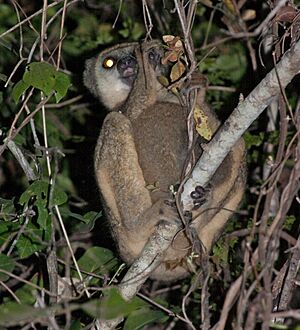Western woolly lemur facts for kids
Quick facts for kids Western woolly lemur |
|
|---|---|
 |
|
| Conservation status | |
| Scientific classification | |
 |
|
| Distribution of A. occidentalis |
The western woolly lemur (also called the western avahi) is a type of woolly lemur. It lives in the dry forests of western Madagascar. These lemurs are active at night (they are nocturnal). They weigh about 0.7 to 0.9 kilograms. They mostly eat leaves, which means they are folivorous. Western woolly lemurs live in small families. Each family usually has a mother, a father, and their young.
Contents
What Do Western Woolly Lemurs Eat?
Western woolly lemurs mainly eat leaves and buds. They prefer young leaves from about 20 different kinds of plants. These young leaves have lots of sugar and protein. The lemurs eat their food high up in trees, usually between 2 and 9 meters off the ground. They typically feed for two hours before sunrise and two hours after sunset. When they eat, they usually sit on thinner branches. However, if a tree is too small, they will find a stronger branch. Because they eat only leaves, western woolly lemurs spend a lot of time resting. This helps them save energy.
How Do Western Woolly Lemurs Behave?
Western woolly lemurs travel in pairs with their mate and their babies. The female lemur is usually in charge of the family. These lemur families are often very peaceful. If there is a disagreement, the female lemur always starts it and also ends it. Female western woolly lemurs are known for not showing that they are less important than their male partners.
Where Do Western Woolly Lemurs Live?
This lemur species lives in northwestern Madagascar. You can find them northeast of Bombetoka Bay.
What Does a Western Woolly Lemur Look Like?
The western woolly lemur has special features. Its face has white, white-grey, or cream-colored fur. This fur creates an outline around its face. There is a small, darker spot of fur just above its nose. The light-colored fur on its face also goes down below its ears. Their eyes are yellow-brown. A black, hairless circle surrounds each eye. The nose is black and has no fur. The fur around its nose is white.
The fur on its head and body is brown-grey or yellowish-brown. This fur is slightly curled and might look like it has tiny spots. Some lemurs might have darker fur along their backs. Their tail is usually pale gray or has hints of greyish-beige. Sometimes, the tail can have red colors, and a few lemurs have a white tip on their tail. The fur on their chest, belly, and inner body parts is quite thin. It can be light beige, cream, or an apricot color.
Why Are Western Woolly Lemurs Important to Protect?
It is hard to keep western woolly lemurs in zoos. This is because they are very picky about the plants they eat. They need specific types of plants to survive. So, the best way to protect these lemurs is to protect the forests where they live. Saving their forest homes helps save the lemurs themselves.


